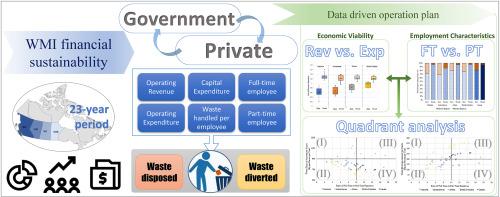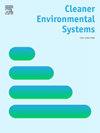Evolution of financial sustainability of Canadian waste management industries in government and private sectors
IF 4.9
Q2 ENGINEERING, ENVIRONMENTAL
引用次数: 0
Abstract
There is a lack of government and private sector-specific analysis on the economic sustainability of waste management services in Canada. This study addresses that gap by conducting a comprehensive 23-year analysis of waste management industry data across four Western Canadian provinces, examining both sectors separately. This distinction enhances understanding of how economic and employment factors uniquely influence waste disposal, diversion, and revenue growth. The study reveals a predominantly private sector led management system, with the highest national revenue in 2018 ($221.9/cap). The private sector's substantial investment in waste diversion significantly impacts its robust revenue growth and consistently higher profit margins. In contrast, the government sector exhibits fluctuating operating revenue, primarily supported by income and property taxes, reflecting an inconsistent financial structure. Lower waste diversion rates in some provinces may be linked to higher proportion of part-time employees in the government sector, impacting financial sustainability. However, recent upward trends in government capital investment suggest a shift toward long-term development goals rather than short-term revenue gains. Findings highlights distinct differences in business and employment characteristics between sectors. The study provides an analytical framework for optimized financial and resource planning within Canada's waste management landscape.

加拿大政府和私营部门废物管理行业财务可持续性的演变
政府和私营部门对加拿大废物管理服务的经济可持续性缺乏具体分析。本研究通过对加拿大西部四个省的废物管理行业数据进行了23年的全面分析,分别检查了这两个部门,从而解决了这一差距。这种区别增强了对经济和就业因素如何独特地影响废物处理、转移和收入增长的理解。该研究揭示了一个主要由私营部门主导的管理系统,2018年全国收入最高(221.9美元/上限)。私营机构在废物转移方面的大量投资对其强劲的收入增长和持续较高的利润率产生了重大影响。相比之下,政府部门的营业收入波动较大,主要由所得税和财产税支撑,反映出财政结构不一致。在一些省份,较低的废物转移率可能与政府部门兼职雇员比例较高有关,从而影响财政可持续性。然而,最近政府资本投资的上升趋势表明,中国正在转向长期发展目标,而不是短期收入增长。调查结果强调了不同行业在商业和就业特征上的明显差异。该研究为加拿大废物管理领域内优化财务和资源规划提供了一个分析框架。
本文章由计算机程序翻译,如有差异,请以英文原文为准。
求助全文
约1分钟内获得全文
求助全文
来源期刊

Cleaner Environmental Systems
Environmental Science-Environmental Science (miscellaneous)
CiteScore
7.80
自引率
0.00%
发文量
32
审稿时长
52 days
 求助内容:
求助内容: 应助结果提醒方式:
应助结果提醒方式:


